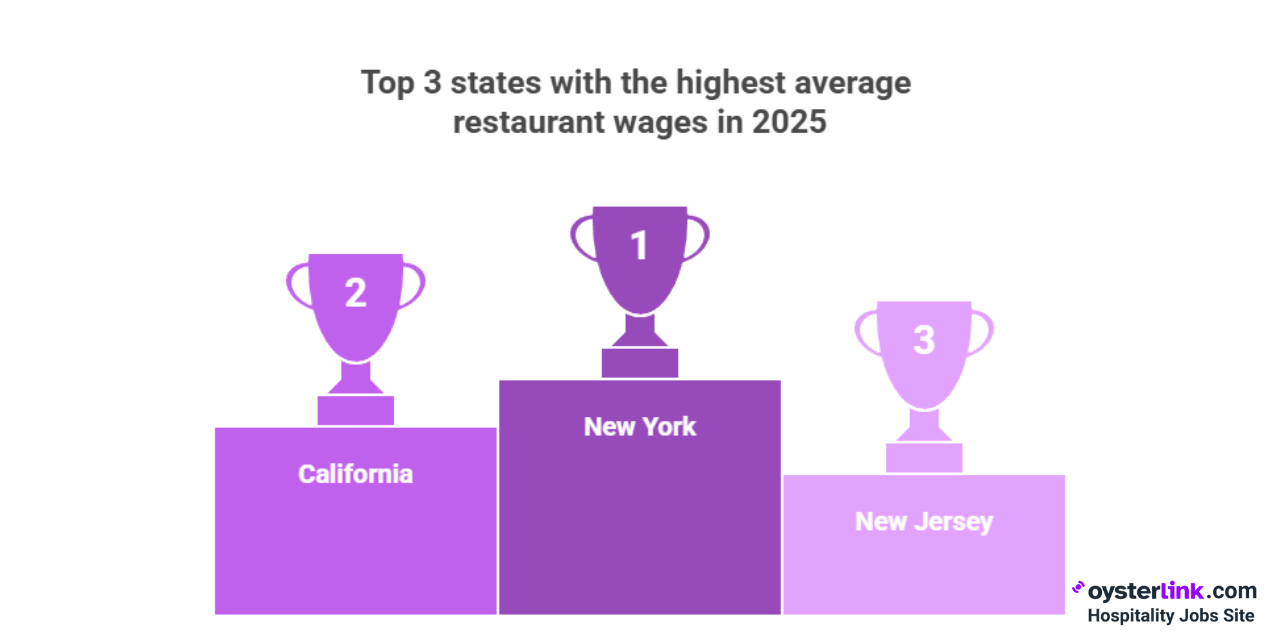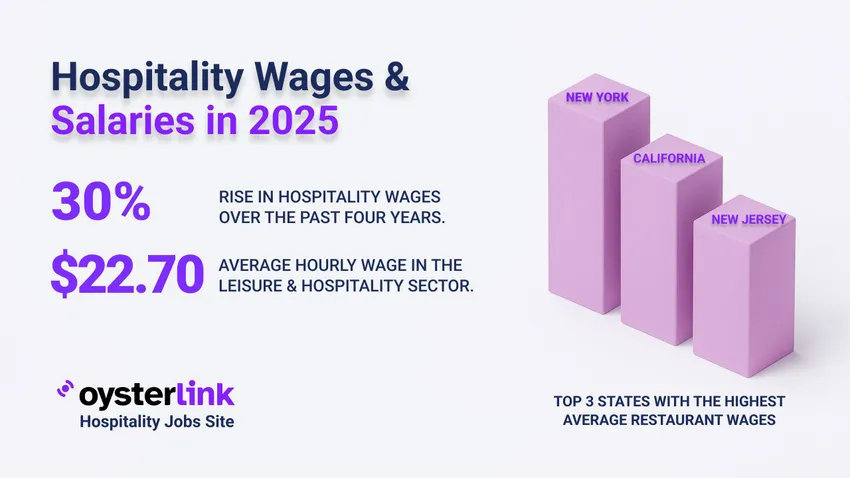The hospitality sector is undergoing a dynamic period of transformation, characterized by significant adjustments to employee compensation.
This article provides an in-depth look at the key statistics and emerging trends shaping hospitality wages and salaries in 2025.
Hospitality Wages and Salaries in 2025
As of April 2025, the average hourly wage across all employees in the Leisure and Hospitality sector is approximately $22.70.
These workers typically clock about 25.5 hours per week, resulting in estimated weekly earnings of roughly $578.85.

Focusing on production and nonsupervisory employees, the average hourly wage is slightly lower at $20.02, with an average weekly schedule of 24.1 hours.
Their estimated weekly earnings are about $482.48.
Annualized Salary Estimates
Based on consistent year-round work, these figures translate into annual earnings of approximately:
- All employees: $30,099 per year
- Production/nonsupervisory employees: $25,089 per year
Hospitality wage rates have shown steady improvement. Additionally, the Employment Cost Index for "Leisure and Hospitality" has risen from 186.9 to 188.3, indicating ongoing wage growth.
In the hotel sector specifically, total wages, salaries and other compensation are projected to grow by approximately 2.13% in 2025, reflecting a continued post-pandemic recovery and upward trend in industry compensation.
This outlook suggests that wages in the hospitality industry are steadily improving, providing more income stability and growth opportunities for workers across the sector.
Reversing the Trend: Wage Gains and Growth Roles
Recent data highlights a positive shift for hospitality's lowest-paid workers. Here are the key insights:
- Pay hikes over the past four years have lifted the wages of people working in hospitality nearly 30% on average, reversing much of the long-term wage inequality that has been growing in the United States.
- Over the past 12 months, average hourly earnings in the hospitality industry have increased by about 3.8%.
- The Employment Cost Index for "Leisure and Hospitality" has risen from 186.9 to 188.3, indicating ongoing wage growth.
- In 40 states, even those that haven’t raised their minimum wage beyond the $7.25 federal floor, recent pay jumps outpaced pay increases in each state’s highest-paying industry, such as energy, technology, or the federal government.
- The lowest-wage industry in every state remains leisure and hospitality, which includes restaurants, bars and hotels. These lowest-earning workers received larger percentage raises than higher earners, with an average boost of 29% between mid-2019 and mid-2023.
- In the hotel sector specifically, total wages, salaries, and other forms of compensation are projected to grow by approximately 2.13% in 2025, reflecting a continued post-pandemic recovery and upward trend in industry pay.
Looking ahead to 2025, several careers within the hospitality sector are expected to undergo significant change and growth. Some of the hottest growth roles include:
- Director of Franchise positions are projected to see the highest growth percentage in 2025, at 45.95%. This significant upswing points to the continued expansion of franchise operations and the increased demand for skilled professionals to manage these ventures.
- Director of Finance is set to grow by 42.54%. This surge underscores the critical role of financial management within the hospitality sector, as businesses seek to optimize revenue, control costs, and navigate complex economic conditions.
- Both the Director of Housekeeping and Director of Human Resources roles are expected to have significant growth as well, at 40.23% and 41.57%, respectively.
These increases highlight the importance of maintaining exceptional service standards and cultivating a skilled, motivated workforce within the hospitality industry.
2025 Data: Average Yearly Income for Restaurant Roles
The table below highlights key roles within the industry, comparing their estimated salaries for 2025 with those from 2024, along with the percentage change.
Role | 2025 Salary | 2024 Salary | Change |
$29,253 | $29,631 | -1.28% | |
$31,740 | $32,021 | -0.88% | |
$32,708 | $34,725 | -5.81% | |
$33,544 | $31,835 | +5.37% | |
$34,012 | $35,354 | -3.80% | |
$38,049 | $36,076 | +5.47% | |
$39,423 | $36,774 | +7.20% | |
Catering Manager | $51,010 | $50,124 | +1.78% |
$52,562 | $40,341 | +30.29% | |
$54,472 | $50,651 | +7.54% | |
$54,579 | $49,912 | +9.35% | |
$55,334 | $52,222 | +5.96% | |
$83,555 | $73,204 | +14.14% | |
$95,626 | $89,867 | +10.08% | |
Director of Franchise | $127,713 | $87,505 | +45.95% |
These numbers indicate significant opportunities for job seekers in the restaurant space, highlighting roles with notable salary growth and potential for advancement.
However, it's also important to recognize that some positions are experiencing slower or negative growth, which may reflect shifts in industry demand, changing responsibilities or automation trends.
For example, roles like Servers and Bartenders have seen salary decreases, possibly due to increased automation or reduced transactional volume in some establishments.
Conversely, positions such as Pastry Chefs, Sous Chefs and Executive Chefs are experiencing strong growth, likely driven by higher customer demand for gourmet experiences and specialized cuisine.
Pro tip: To capitalize on these opportunities, it may be worthwhile for individuals to pursue training and skill development in high-growth areas to increase their earning potential.
Geographical Wage Disparities in 2025: Restaurants
Earnings in the restaurant industry can vary significantly depending on location.
Salaries tend to be higher in states with a strong industry presence, influenced by factors such as the cost of living, local demand and regulations.
The 10 states with the highest average wages in 2025 are:
- New York
- California
- New Jersey
- Connecticut
- Alaska
- Colorado
- Oregon
- Massachusetts
- Washington
- Hawaii

Conversely, some states tend to have lower wages within the industry. These states typically feature lower living costs and different industry dynamics.
The 10 states with the lowest average wages in 2025 are:
- Iowa
- Montana
- Oklahoma
- Alabama
- Kentucky
- Louisiana
- Mississippi
- Florida
- Arkansas
- West Virginia
Understanding these regional disparities can help industry professionals and job seekers make informed decisions about where to pursue opportunities and how regional factors influence earning potential.
The Significance of Award Rates and Benefits
Offering fair wages and meaningful benefits has become essential for attracting and retaining talented employees in the hospitality industry.
Companies that recognize the value of providing a strong rewards package are better positioned to stand out and foster loyalty among their staff.
A successful HR strategy should focus on several key components:
- Competitive hospitality wage rates: Ensuring pay aligns with industry standards and accurately reflects employees’ contributions.
- Comprehensive benefits: Providing healthcare, retirement plans, paid time off, and other perks that support overall well-being.
- Opportunities for growth: Investing in training, mentorship and clear career pathways to help employees develop and advance.
- Flexibility and work-life balance: Offering flexible schedules and programs that promote a healthy balance between work and personal life.
Today’s workers are seeking more from their employers — they want workplaces that value their contributions, support their needs and deliver real value.
Forward-thinking hospitality companies understand this shift and are adapting their offerings to create environments where employees feel appreciated, motivated and eager to stay.
Challenges and Opportunities in 2025
In 2025, business leaders in the restaurant and hospitality space will continue to face the ongoing challenge of balancing profits and worker pay.
Rising wages present significant opportunities for employers willing to embrace innovative strategies, like:
- Technological improvements and automations.
- Creating an efficient workflow
- Robust training to give workers upward mobility
- Investing in the right locations to help reduce the operating expenses and indirect costs.
Businesses that make effective use of these methods will be able to embrace the challenges and find long-term success. Additionally, they can boost the compensation and job satisfaction of their most valued assets — their workers.
Methodology
This analysis combines data from recent industry articles, reports, expert insights and official statistics to highlight the key trends and figures concerning hospitality wages and salaries in 2025.
The primary data sources include the U.S. Bureau of Labor Statistics (BLS), the Restaurant Zone Restaurant & Hospitality Industry Salary Report, and the Stateline article “Hospitality workers’ wages are rising faster than high earners’ in most states”.










Loading comments...